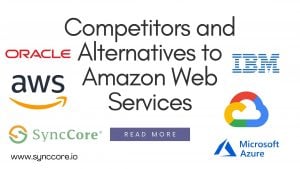How to Choose the Right Cloud Computing Service Provider: Businesses increasingly rely on cloud services to support infrastructure (servers, storage, databases, networking), software, or services to provide flexibility, performance, scalability, innovation, and cost savings.
The global pandemic has hastened digital transformation, with 90 percent of businesses citing increased cloud usage due to COVID-19 to support remote work, fulfill the demand for tailored customer experiences, and maintain system uptime. Gartner projects that by 2026, public cloud investment would account for more than 45 percent of all IT spending, up from 17 percent in 2021.

Table of Contents
What is a Cloud Service Provider?
A network of computers provides cloud computing services over the internet. A cloud service provider (CSP) or cloud platform is a third-party company that offers cloud computing services such as establishing public clouds, managing private clouds, and providing on-demand cloud services.
Amazon Web Services (AWS) is currently the most popular and widely used cloud service provider, accounting for 32 percent of the market share. Some popular public cloud providers are Microsoft Azure, Google Cloud, IBM Cloud, and SyncCore Cloud.
What is Cloud Computing?
Let’s break down cloud computing by kind of cloud and type of cloud service to understand better what a cloud service provider performs.
Three types of cloud computing models will be used to implement cloud services. These models, often known as cloud computing architecture, are as follows:
A private cloud is a cloud computing resource deployment for a single enterprise, either on-premise or privately hosted by a cloud service provider. Organizations are responsible for the cost of managing the private cloud in a private cloud.
Over the Internet, a public cloud provides cloud computing resources. A third-party cloud service provider owns and operates a public cloud.
A hybrid cloud approach combines the two choices, private and public cloud.
Challenges of Using a Cloud Service Provider
The following are some of the difficulties in how to choose the right cloud computing service provider
Lack of Support:
Some cloud providers may lack the documentation or support staff to assist clients, preferring to focus more resources on sales, so choose your cloud provider carefully.
Security threat in the cloud:
Cloud computing raises concerns about cyber-attacks by expanding the attack surface outside the organization’s boundaries. Finding the correct cloud service provider and participating actively in shared responsibility, particularly around access and identity-proof authentication can increase security.
Technical Issues:
Any new technology necessitates the presence of knowledgeable IT personnel as well as training for all users. On the other hand, some cloud service providers are generally more user-friendly or include features that simplify setup, migration, or use.
Performance can vary:
While every cloud service provider will offer performance and availability claims, actual results may differ.
How Do I Choose a Cloud Provider? Factors to Consider
Finally, while selecting a new cloud provider, businesses should examine the following factors:
- Cost
Consider the cost of use (upfront vs. pay-as-you-go) and any cost minimums, volume discounts, service reservations, or billing type (e.g., hour/month, execution, user, or gigabyte). Also, consider the cost of other aspects. AWS, for example, has innovated its CPU engineering to give the best price/performance compared to all competitors. Many cloud providers will offer attractive first-time customer pricing, so read the fine print concerning price hikes over time.
2. Security & Reliability
Organizations must consider things like robust security and the provider’s robustness, paying particular attention to regional capabilities and uptime statistics in the past. Document disaster recovery plans, backup/restore procedures, integrity checks, and each party’s roles and responsibilities. Most cloud service providers will include the available security features (free or premium) and integrations. Examine specific areas such as identity management, access controls, authentication, and the storage and processing of data.
3. Compliance
When selecting a cloud provider, businesses must examine the consequences of federal, state, and industry regulations. Cloud providers should be able to address inquiries regarding compliance with specific legislation if they have a statement of shared responsibility for compliance. Particular rules may ban the storage, transport, or processing of customer data by cloud providers whose data storage capabilities are located inside a distinct geographic border or impose specific protection, confidentiality, or access control requirements. Each regulation has its own set of rules for breach reaction and reporting.
4. HIPAA
As long as the infrastructure and all of its elements and integrations are HIPAA compliant in terms of administrative, physical, and technical security, the cloud can be used in healthcare for the backend, data sharing, or patient-facing applications. The seller must sign a business associate agreement. HHS provides HIPAA and Cloud Computing guidelines here.
5. GDPR
GDPR applies to enterprises based in the EU or process data for EU citizens and includes special obligations for data protection, processing records, and process security. Data storage and processing must occur in EU data centers, and data transfers beyond the EU are subject to certain restrictions.
6. ISO
To be ISO compliant, a cloud service provider must be able to show certifications such as ISO 27001 (for information security management systems) and ISO 27018 (for information security management systems) (code of practice for protection of personally identifiable information in public clouds acting as PII processors). ISO standards apply to organizations in over 160 countries.
7. Tools & Features
Different functions will be included as part of the standard capabilities or as add-ons by each cloud service provider. Look for both types of service (PaaS) and specific characteristics such as computer resources, monitoring, security, deployment options, and user experience. According to Gartner, Microsoft has the widest variety of SaaS, PaaS, and IaaS capabilities.
8. Business Compatibility
The cloud service provider must be compatible with the organization’s business, technological, and operational objectives.
6. Architecture
Consider how the cloud architecture integrates existing technology or services within the firm, as keeping within huge ecosystems such as Microsoft, Amazon, or Google offers both technological and cost synergies. Check that the cloud provider you choose can meet your current and future demands, including multi-cloud, microservices, container support, and serverless choices.
7. Contracts, Commercials & SLAs
Contracts and SLAs should be thoroughly evaluated and, if necessary, modified. Ensure the SLA contains a penalty or exit clause if service levels are not met. Many organizations include force majeure clauses in their contracts due to COVID-19’s experiences.
8. Migration Support, Vendor Lock-in & Exit Planning
According to Gartner, contract or proprietary technology-based vendor lock-in is a big worry, which is why some cloud providers are pressing annual expenditure increases at contract renewal time. Organizations are addressing this issue by utilizing many cloud service providers and avoiding proprietary technology that can result in lock-in.
9. Data Migration Support
Examine the migration services provided by each cloud provider. Most cloud service providers offer migration assessment tools, including database, server, and application migration tools.
10. Data Governance
Cloud governance describes the regulations and procedures that govern cloud services in terms of privacy, security, and cost. To prevent the overuse of cloud resources, these controls could, for example, set a maximum budget for an organization or department for cloud use.
11. Project Size
The cloud service provider will have varying needs depending on the project’s size, scope, and goals.
Conclusion
One of the most prevalent reasons for cloud migration failure is a lack of planning: understanding the business goals, the benefits and drawbacks of different cloud service providers, and the knowledge needed to develop for the cloud today. With the support of a dependable partner, many of these frequent cloud failure issues can be resolved.
Choosing the right cloud computing companies is vital for businesses. SyncCore provides a hybrid solution, PaaS, and a variety of other valuable capabilities that are critical in today’s Cloud strategy. Migrating to SyncCore Cloud has increased business growth for many companies.
Read More:



